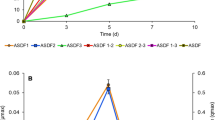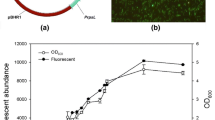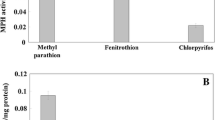Abstract.
A consortium comprised of two engineered microorganisms was assembled for biodegradation of the organophosphate insecticide parathion. Escherichia coli SD2 harbored two plasmids, one encoding a gene for parathion hydrolase and a second carrying a green fluorescent protein marker. Pseudomonas putida KT2440 pSB337 contained a p-nitrophenol-inducible plasmid-borne operon encoding the genes for p-nitrophenol mineralization. The co-culture effectively hydrolyzed 500 μM parathion (146 mg l−1) and prevented the accumulation of p-nitrophenol in suspended culture. Kinetic analyses were conducted to characterize the growth and substrate utilization of the consortium members. Parathion hydrolysis by E. coli SD2 followed Michaelis–Menten kinetics. p-Nitrophenol mineralization by P. putida KT2440 pSB337 exhibited substrate-inhibition kinetics. The growth of both strains was inhibited by increasing concentrations of p-nitrophenol, with E. coli SD2 completely inhibited by 600 μM p-nitrophenol (83 mg l−1) and P. putida KT2440 pSB337 inhibited by 1,000 μM p-nitrophenol (139 mg l−1). Cultivation of the consortium as a biofilm indicated that the two species could cohabit as a population of attached cells. Analysis by confocal microscopy showed that the biofilm was predominantly comprised of P. putida KT2440 pSB337 and that the distribution of E. coli SD2 within the biofilm was heterogeneous. The use of biofilms for the construction of degradative consortia may prove beneficial.



Similar content being viewed by others
References
Adams RH, Huang CM, Higson FK, Brenner V, Focht DD (1992) Construction of a 3-chlorobiphenyl-utilizing recombinant from an intergeneric mating. Appl Environ Microbiol 58:647–654
Adriaens P, Kohler HPE, Kohler-Staub D, Focht DD (1989) Bacterial dehalogenation of chlorobenzoates and coculture biodegradation of 4,4'-dichlorobiphenyl. Appl Environ Microbiol 55:887–892
Alvey S, Crowley DE (1996) Survival and activity of an atrazine-mineralizing bacterial consortium in rhizosphere soil. Environ Sci Technol 30:1596–1603
Andrews JF (1968) A mathematical model for the continuous culture of microorganisms utilizing inhibitory substrates. Biotechnol Bioeng 10:707–723
Arfmann H-A, Timmis KN, Wittich R-M (1997) Mineralization of 4-chlorodibenzofuran by a consortium consisting of Sphingomonas sp. strain RW1 and Burkholderia sp. strain JWS. Appl Environ Microbiol 63:3458–3462
Bang S-W, Zylstra GJ (1996) Cloning and characterization of genes involved in p-nitrophenol degradation by Pseudomonas fluorescens ENV2030. Abstr Annu Meet Am Soc Microbiol 96:414
Bastiaens L, Springael D, Wattiau P, Harms H, De Wachter R, Verachtert H, Diels L (2000) Isolation of adherent polycyclic aromatic hydrocarbon (PAH)-degrading bacteria using PAH-sorbing carriers. Appl Environ Microbiol 66:1834–1843
Casellas M, Grifoll M, Sabata J, Solanas AM (1998) Isolation and characterization of a 9-fluorenone-degrading bacterial strain and its role in synergistic degradation of fluorene by a consortium. Can J Microbiol 44:734–742
Cho J-H, Kim E-K, So J-S (1995) Improved transformation of Pseudomonas putida KT2440 by electroporation. Biotechnol Tech 9:41–44
Cowan SE, Keasling JD (2001) Development of engineered biofilms on poly-l-lysine patterned surfaces. Biotechnol Lett 23:1235–1241
Cowan SE, Gilbert E, Khlebnikov A, Keasling JD (2000a) Dual labeling with green fluorescent proteins for confocal microscopy. Appl Environ Microbiol 66:413–418
Cowan SE, Gilbert E, Liepmann D, Keasling JD (2000b) Commensal interactions in a dual-species biofilm exposed to mixed organic compounds. Appl Environ Microbiol 66:4481–4485
Edwards VH (1970) The influence of high substrate concentration on microbial kinetics. Biotechnol Bioeng 12:679–712
Haro M-A, Lorenzo V de (2001) Metabolic engineering of bacteria for environmental applications: construction of Pseudomonas strains for biodegradation of 2-chlorotoluene. J Biotechnol 85:103–113
Jones KL, Keasling JD (1998) Construction and characterization of F plasmid-based expression vectors. Biotechnol Bioeng 59:659–665
Katsivela E, Bonse D, Krueger A, Stroempl C, Livingston A, Wittich RM (1999) An extractive membrane biofilm reactor for degradation of 1,3-dichloropropene in industrial waste water. Appl Environ Microbiol 52:853–862
Kjaergaard K, Schembri MA, Hasman H, Klemm P (2000) Antigen 43 from Escherichia coli induces inter- and intraspecies cell aggregation and changes in colony morphology of Pseudomonas fluorescens. J Bacteriol 182:4789–4796
Komukai-Nakamura S, Sugiura K, Yamauchi-Inomata Y, Toki H, Venkateswaran K, Yamamoto S, Tanaka H, Harayama S (1996) Construction of bacterial consortia that degrade Arabian light crude oil. J Ferment Bioeng 82:570–574
Luong JHT (1987) Generalization of Monod kinetics for analysis of growth data with substrate inhibition. Biotechnol Bioeng 29:242–248
Mulbry W, Karns JS (1989) Purification and characterization of three parathion hydrolases from gram-negative bacterial strains. Appl Environ Microbiol 55:289–293
Mulbry WW, Karns JS, Kearney PC, Nelson JO, McDaniel CS, Wild JR (1986) Identification of a plasmid-borne parathion hydrolase gene from Flavobacterium sp. by Southern hybridization with opd from Pseudomonas diminuta. Appl Environ Microbiol 51:926–930
Munkres KD, Richards FM (1965) The purification and properties of Neurospora malate dehydrogenase. Arch Biochem Biophys 109:466–479
Oh YS, Bartha R (1997) Construction of a bacterial consortium for the biofiltration of benzene, toluene and xylene emissions. World J Microbiol Biotechnol 13:627–632
Park H-S, Lim S-J, Chang YK, Livingston AG, Kim H-S (1999) Degradation of chloronitrobenzenes by a coculture of Pseudomonas putida and a Rhodococcus sp. Appl Environ Microbiol 65:1083–1091
Ramos JL, Haidour A, Duque E, Pinar G, Calvo V, Oliva J-M (1996) Metabolism of nitrate esters by a consortium of two bacteria. Nat Biotechnol 14:320–322
Richins RD, Kaneva I, Mulchandani A, Chen W (1997) Biodegradation of organophosphorus pesticides by surface-expressed organophosphorus hydrolase. Nat Biotechnol 15:984–987
Schweizer HP (1994) A method for construction of bacterial hosts for lac-based cloning and expression vectors: alpha-complementation and regulated expression. Biotechniques 17:452–4, 456
Shapir N, Mandelbaum RT, Jacobsen CS (1998) Rapid atrazine mineralization under denitrifying conditions by Pseudomonas sp. strain ADP in aquifer sediments. Environ Sci Technol 32:3789–3792
Sutherland TD, Horne I, Lacey MJ, Harcourt RL, Russell RJ, Oakeshott JG (2000) Enrichment of an endosulfan-degrading mixed bacterial culture. Appl Environ Microbiol 66:2822–2828
Van Hylckama Vlieg JET, Janssen DB (2001) Formation and detoxification of reactive intermediates in the metabolism of chlorinated ethenes. J Biotechnol 85:81–102
Wackett LP, Sadowsky MJ, Newman LM, Hur HG, Li S (1994) Metabolism of polyhalogenated compounds by a genetically engineered bacterium. Nature 368:627–629
Wang CL, Maratukulam PD, Lum AM, Clark DS, Keasling JD (2000) Metabolic engineering of an aerobic sulfate reduction pathway and its application to precipitation of cadmium on the cell surface. Appl Environ Microbiol 66:4497–4502
Wittich RM, Stroempl C, Moore ERB, Blasco R, Timmis KN (1999) Interaction of Sphingomonas and Pseudomonas strains in the degradation of chlorinated dibenzofurans. J Ind Microbiol Biotechnol 23:353–358
Acknowledgements.
This work was supported by the National Science Foundation (BES-9814088), the Office of Naval Research (N00014-99-1-0182), and the University of California Center for Water Resources (W-946). The plasmid pSB337 was a gift from S. Bang and G. Zylstra, Rutgers University. We thank Carolyn Larabell, Lawrence Berkeley National Laboratories, for assistance with confocal microscopy, and acknowledge Samir Davila and Richard Tsai for their assistance.
Author information
Authors and Affiliations
Corresponding author
Rights and permissions
About this article
Cite this article
Gilbert, E.S., Walker, A.W. & Keasling, J.D. A constructed microbial consortium for biodegradation of the organophosphorus insecticide parathion. Appl Microbiol Biotechnol 61, 77–81 (2003). https://doi.org/10.1007/s00253-002-1203-5
Received:
Revised:
Accepted:
Published:
Issue Date:
DOI: https://doi.org/10.1007/s00253-002-1203-5




